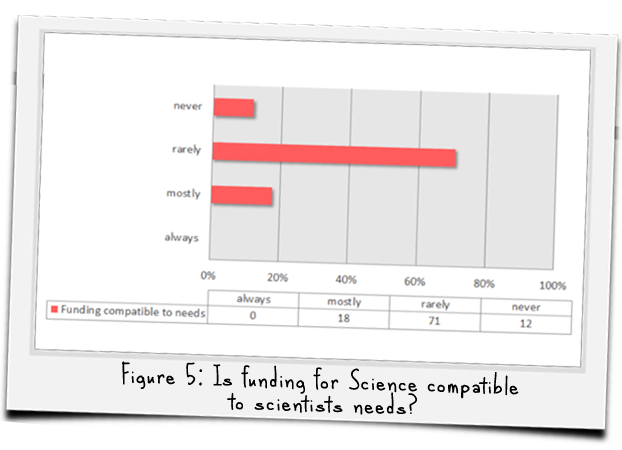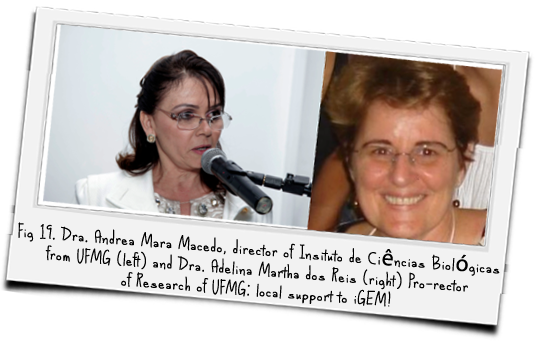Team:UFMG Brazil/Project/Policy
From 2014.igem.org
| Line 289: | Line 289: | ||
<h3 style="color: #2e3e4b;">Local action: UFMG</h3>. | <h3 style="color: #2e3e4b;">Local action: UFMG</h3>. | ||
| - | <p>To begin our quest to make Science and iGEM known and valued, we met with the Director of the Institute of Biological | + | <p>To begin our quest to make Science and iGEM known and valued, we met with the Director of the Institute of Biological Sciences from UFMG, Dra.Andréa Mara Macedo (Fig19), who supported our team to attend to the Giant Jamboree in Boston. She was really interested in our initiative to participate in iGEM and also helped us to meet funding agencies which could support us. </p> |
<br> | <br> | ||
Revision as of 03:59, 18 October 2014
A little bit of information about the problem
By the end of 2013 iGEM World Jamboree...
...iGEM Foundation vice-president Meagan Lizarazo came to us with a question: Why does Latin America have such a low participation on iGEM? And what could we do to improve that?
To answer those questions, team UFMG 2014 worked hard and focused our human practices on this subject.
We analyzed the data on iGEM team participation over the years. As we can observe in the graphs, iGEM grows every year (Figure 1), and Latin America participation grows too (Figure 2).


However, our share of participation, in comparison with other continents, is really small. We are stuck at a ~5% participation, which has oscillated but not really changed over the years. Asia and Europe started their participation on iGEM at low rates as well, but they were able to grow. Since around 2010, Asia, Europe and North America converged to an equal participation on iGEM, having a share of around 30% each (Figure 3), while Latin America runs far behind.

But why does this happen? Why can’t Latin America improve its participation on iGEM?
Why?
To investigate why Latin America is not well represented on iGEM, we decided to apply a questionnaire to all teams from Latin America that have participated in iGEM over the years.
During our brainstorms to formulate the questionnaire, we noticed that the obstacles we face taking part on iGEM are pretty much the same ones that impair the development of all scientific research in our region.
Our questionnaire was then targeted on the difficulty of doing research in Latin America as a whole, focusing on problems we have struggled with and which we believe are the main barriers for Science here.
It consisted of seven questions:
- What is the limiting factor for scientific research project development?
- On average, how long does it take to get the imported orders in your lab?
- How was your experience of import for scientific research projects?
- Have you ever been forced to abandon a project due to problems with the import of material?
- Is funding provided by development agencies compatible with your needs?
- How do you rate the financial support provided by development agencies?
- Is there any bill in your country to improve the import situation?
The first limitation we faced doing this research was the few responses received. To increase the chances of feedback, we decided to send our questionnaire to other universities from Latin America not necessarily participants of iGEM and we still got few responses. From 266 emails sent, we got 16 answers.
Questionnaire Results
Analyzing the answers to the first question of our survey, it was clear that Latin America faces important issues to do research. Notably, the lack of qualified personnel was not a problem that came up, indicating that we have indeed interested, capable scientists who are eager to do more for science!
In addition to infra-structure, funding was indicated as the main difficulty to do Science (Figure 4).

Latin American countries are still on track to become developed, but when it comes to funding in Science, the competition with well established nations, such as the USA and European countries, is an uneven game. Considering this, we can say that funding in developed countries is more abundant than in Latin America for sure.
The budget dedicated to Science investment is managed by support agencies, which distribute the money through specific bids. More than 70% of the interviewed said that the funding provided by support agencies rarely is compatible with their needs (Fig 5) and the support agencies that provide the funding are rated only as reasonable (Fig 6).


Comparing Brazil and USA’s gross domestic product (GDP), we can clearly see that USA is a richer nation than Brazil (Figure 7). More money for the country, more money to invest! Therefore, since funding is a problem in Science and for the iGEM participation as well, USA being a richer nation, it obviously has more funded teams participating on the competition than Brazil (Figure 8).


But this is not the only problem. There is more to that. USA GDP in 2013 was ≅ 16,8 trillion USD and ≅ 2,8 % of it was invested in Science somehow, representing a funding of ≅ 470,4 billion USD. Brazil’s GDP in 2013 was ≅ 2,246 trillion USD and only ≅ 1,2% was invested in Science, representing ≅ 26,952 billion, an amount 94,3% smaller than what was invested in Science by the USA. Brazil cannot invest the same, but if a higher percentage of the GDP was invested in Science, we could at least begin to lay down the barriers to do research in our country. To do it, Science should be more valued and regarded as a priority. Convincing the government that Science deserves more fundingshould be something claimed by the society. But is funding Science considered important by the Brazilian population?
To assess whether the low investment in Science by the government is supported by general population, we designed another survey. We asked general population, on the streets and among our social networks contacts, on a scale from 1 to 10, how important for them it is to invest in Science in Brazil? In addition to that, we asked what was the first word that came to their minds when they thought about Science.
The results show that people think it is indeed important to invest in Science and more than ¾ rated this importance from 8 to 10 (Fig 9) .

Concerning the words people relate to Science, most of them revealed positive concepts, in the field of progress, like KNOWLEDGE, ADVANCES, INNOVATION, DEVELOPMENT and EVOLUTION. TECHNOLOGY was also greatly remembered (Fig 10). However, something caught our attention: 5,28% of interviewed people could not relate Science to anything. When we analyze only the results from the survey made on the streets, excluding the answers from social networks, this proportion rises to 15%! It’s a substantial amount of people that are not familiar with the universe of Science. This indicated to us that Science popularization is very important in our country, if we want Science to be greater valued.

In addition to the lack of investment in Science by the government, private enterprises also do not invest much in Science in Brazil (Fig.11). The private sector is responsible for less than 50% of spending in R&D. Other nations which are in the beginning of the development process, like China and India, have a share of more than 70% of the investment being made by the private sector. This may contribute to the fact that Asia is better represented in iGEM: because developing asian countries value Science more. In Latin America, Argentina runs even worse in this field.

Other important problem for research in Latin America addressed in our survey was the importation experience (Figure 12). Many reactants used in research are produced elsewhere, out of Latin America and the countries from this continent face a great difficulty in acquiring those reagents. Since iGEM happens in a short period of time, reagents necessary aquired to project development that are not received in time happens often, limiting the experiments and compromising the quality of the project.
In our survey, more than 40% of the answers said they had bad importation experiences.

Moreover, because the vast bureaucracy of the import supervision agencies, the arrival time of the material is extremely long , often exceeding 2 months (Figure 13).

This delay impairs the quality of the reagents and affects project development, because during the long time the reagent takes to arrive to its destiny they are not properly stored, presenting worst quality or even inactivating reagents such as enzymes and antibodies.
Sometimes, the long wait can cause the abandonment of the project (Figure 14).

In addition to be time consuming, the importation process is also expensive. The price of reagents in Brazil are in average three times higher when compared to USA and Europe, burdening even more the limited science funding available.
The good news for us in Brazil is that former soccer legend and now congressman Romário de Souza Faria (Fig 15), is trying to approve a new law (Project of Law 4.411/12http://www.camara.gov.br/proposicoesWeb/prop_mostrarintegra?codteor=1024048) which would facilitate importation of goods for research and technology, accelerating the time these goods take to get to their destination. We believe this is a very important initiative to start to improve our participation in the world scenery of science.
We tried to contact Romario’s accessors to talk about his law project, but it was election times in Brazil, so it was not possible. Fortunately, Romário was just reelected for more 8 years in the congress, giving us the opportunity to further discuss this important issue to Science development in Brazil.

In this context, we asked others Latin America universities whether or not there is some government initiative to improve the importation situation in their countries, and unfortunately, most of them does not even know about any bill in this field (Fig 16).

Solutions
We believe that Science is important and that it can change the world. We think synthetic biology can help. We also believe in iGEM and we wish that brazilian students have the opportunity to be a part of it. So, what could we do to make it possible, overcoming the issues previously rose?
First, it was clear to us that we have to make science, synthetic biology and iGEM known! If the general brazilian public is aware of the importance of Science, Science would be better valued and maybe the government, as well as the private initiative, would be more interested on financing scientific projects.
To accomplish this, we gave lectures in educational centers. We covered, mid-school, at city School Sócrates Mariani Bittencourt (fig 17), and high school, Technical school and Graduation, at CEFET, a Brazilian federal educational institution subordinated to the Brazilian Ministry of Education of great reputation (Fig18).
Our lectures covered different fields in Science, highlighting their importance, and presented synthetic biology and iGEM to the students.


Even with all the problems that we faced on 2013 to participate on iGEM, here we are again. In 2014, the challenges were still difficult to overcome. In 2015, we want that UFMG team can face a better scenario. So we worked harder at local, state, federal and continental levels to show how important it is for UFMG and other Brazilian teams to participate in such an interesting and instigating competition as iGEM. It is a great experience for the students where they can take risks in developing audacious projects which they might not be able to do during the undergrad life or in their own masters or PhDs projects. We also wanted them to acknowledge that Brazil is a country growing economically in the world scenario and should invest more in science as other developed countries do.
Local action: UFMG
.To begin our quest to make Science and iGEM known and valued, we met with the Director of the Institute of Biological Sciences from UFMG, Dra.Andréa Mara Macedo (Fig19), who supported our team to attend to the Giant Jamboree in Boston. She was really interested in our initiative to participate in iGEM and also helped us to meet funding agencies which could support us.
We also got together with Pro-rector of Research of UFMG, Dra.Adelina Martha dos Reis (Fig 19), that helped with funding for iGEM teams since 2013.
In addition to financial support, these meetings assured less bureaucracy to use this support. An annual edict to form the iGEM team will be annually provided by the University and even the donation of physical space to build a bio hacker space where iGEM could take place is under analysis. Dra.Macedo and Dra.Reis are committed to help us to give iGEM more visibility in the scientific community.
Having the full support of our University to participate and develop iGEM is a great achievement for us!

State action: FAPEMIG
.FAPEMIG is a funding agency that support science projects developed in the state of Minas Gerais, where UFMG team is. In the beginning of this year, we wrote them asking for support to our team to participate in iGEM. In September, we received the news that they would support us, however the money could come only in December, which would not help us anymore. Not surprisingly, this exact same situation happened last year as well, and UFMG 2013 team also did not get the FAPEMIG support on time.
Thinking on solving this recurrent problem, we managed to meet with FAPEMIG Director Dr.Evaldo Vilela (Fig 20). We explained him our situation. He was very attentive and is making efforts to extend the deadline for using the funding we received this year in 2015. A scholarship specifically directed to student participation on iGEM, granted by FAPEMIG, was also debated and Dr.Vilela thinks it will be a reality for next year. In addition, he promised to take actions to facilitate funding for all scientific competitions. He also demanded that we wrote a project to further discuss our ideas.

National action: Minister of Science
.The former rector of UFMG, Dr.Clélio Campolina (Fig 21) in now National minister of Science and Technology. We had the honour to meet with him during a visit to UFMG. We presented him iGEM and all the difficulties we have been through to take part in it. He was very excited with our achievements and compassionate with the problems we faced. He gave us some tips on how to pursue funding and promised to help with everything in his power.

Continental action: Latin network
.When we began our Human Practices, we wanted to count on the latin teams that had previously participated on iGEM. However, we got very few answers from them.
This indicates a lack of communication among students and scientists in Latin America. We live in similar conditions and face similar problems to do Science and to participate on iGEM. If we interacted more, we could help and support each other more to overcome the difficulties found on the way.
Aiming to approximate latin teams, we created iGEM Latin America fan-page on facebook (fig 22).

In addition , we are also launching a campaign to form the Latin Network on iGEM (Fig 23). During the Giant Jamboree, we are planning to get toghether with our Latin pairs and share with them our ideas!

With all of these actions, we hope to improve Latin participation on iGEM and we are not afraid to dream that we can also make a difference for Science as a whole in our country!
 "
"